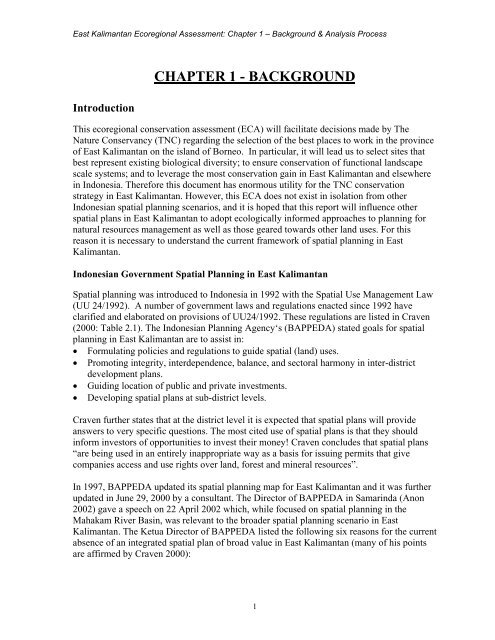Ecoregional Assessment of Biological Diversity in East Kalimantan
Ecoregional Assessment of Biological Diversity in East Kalimantan
Ecoregional Assessment of Biological Diversity in East Kalimantan
Create successful ePaper yourself
Turn your PDF publications into a flip-book with our unique Google optimized e-Paper software.
<strong>East</strong> <strong>Kalimantan</strong> <strong>Ecoregional</strong> <strong>Assessment</strong>: Chapter 1 – Background & Analysis Process<br />
Introduction<br />
CHAPTER 1 - BACKGROUND<br />
This ecoregional conservation assessment (ECA) will facilitate decisions made by The<br />
Nature Conservancy (TNC) regard<strong>in</strong>g the selection <strong>of</strong> the best places to work <strong>in</strong> the prov<strong>in</strong>ce<br />
<strong>of</strong> <strong>East</strong> <strong>Kalimantan</strong> on the island <strong>of</strong> Borneo. In particular, it will lead us to select sites that<br />
best represent exist<strong>in</strong>g biological diversity; to ensure conservation <strong>of</strong> functional landscape<br />
scale systems; and to leverage the most conservation ga<strong>in</strong> <strong>in</strong> <strong>East</strong> <strong>Kalimantan</strong> and elsewhere<br />
<strong>in</strong> Indonesia. Therefore this document has enormous utility for the TNC conservation<br />
strategy <strong>in</strong> <strong>East</strong> <strong>Kalimantan</strong>. However, this ECA does not exist <strong>in</strong> isolation from other<br />
Indonesian spatial plann<strong>in</strong>g scenarios, and it is hoped that this report will <strong>in</strong>fluence other<br />
spatial plans <strong>in</strong> <strong>East</strong> <strong>Kalimantan</strong> to adopt ecologically <strong>in</strong>formed approaches to plann<strong>in</strong>g for<br />
natural resources management as well as those geared towards other land uses. For this<br />
reason it is necessary to understand the current framework <strong>of</strong> spatial plann<strong>in</strong>g <strong>in</strong> <strong>East</strong><br />
<strong>Kalimantan</strong>.<br />
Indonesian Government Spatial Plann<strong>in</strong>g <strong>in</strong> <strong>East</strong> <strong>Kalimantan</strong><br />
Spatial plann<strong>in</strong>g was <strong>in</strong>troduced to Indonesia <strong>in</strong> 1992 with the Spatial Use Management Law<br />
(UU 24/1992). A number <strong>of</strong> government laws and regulations enacted s<strong>in</strong>ce 1992 have<br />
clarified and elaborated on provisions <strong>of</strong> UU24/1992. These regulations are listed <strong>in</strong> Craven<br />
(2000: Table 2.1). The Indonesian Plann<strong>in</strong>g Agency‘s (BAPPEDA) stated goals for spatial<br />
plann<strong>in</strong>g <strong>in</strong> <strong>East</strong> <strong>Kalimantan</strong> are to assist <strong>in</strong>:<br />
• Formulat<strong>in</strong>g policies and regulations to guide spatial (land) uses.<br />
• Promot<strong>in</strong>g <strong>in</strong>tegrity, <strong>in</strong>terdependence, balance, and sectoral harmony <strong>in</strong> <strong>in</strong>ter-district<br />
development plans.<br />
• Guid<strong>in</strong>g location <strong>of</strong> public and private <strong>in</strong>vestments.<br />
• Develop<strong>in</strong>g spatial plans at sub-district levels.<br />
Craven further states that at the district level it is expected that spatial plans will provide<br />
answers to very specific questions. The most cited use <strong>of</strong> spatial plans is that they should<br />
<strong>in</strong>form <strong>in</strong>vestors <strong>of</strong> opportunities to <strong>in</strong>vest their money! Craven concludes that spatial plans<br />
“are be<strong>in</strong>g used <strong>in</strong> an entirely <strong>in</strong>appropriate way as a basis for issu<strong>in</strong>g permits that give<br />
companies access and use rights over land, forest and m<strong>in</strong>eral resources”.<br />
In 1997, BAPPEDA updated its spatial plann<strong>in</strong>g map for <strong>East</strong> <strong>Kalimantan</strong> and it was further<br />
updated <strong>in</strong> June 29, 2000 by a consultant. The Director <strong>of</strong> BAPPEDA <strong>in</strong> Samar<strong>in</strong>da (Anon<br />
2002) gave a speech on 22 April 2002 which, while focused on spatial plann<strong>in</strong>g <strong>in</strong> the<br />
Mahakam River Bas<strong>in</strong>, was relevant to the broader spatial plann<strong>in</strong>g scenario <strong>in</strong> <strong>East</strong><br />
<strong>Kalimantan</strong>. The Ketua Director <strong>of</strong> BAPPEDA listed the follow<strong>in</strong>g six reasons for the current<br />
absence <strong>of</strong> an <strong>in</strong>tegrated spatial plan <strong>of</strong> broad value <strong>in</strong> <strong>East</strong> <strong>Kalimantan</strong> (many <strong>of</strong> his po<strong>in</strong>ts<br />
are affirmed by Craven 2000):<br />
1

















